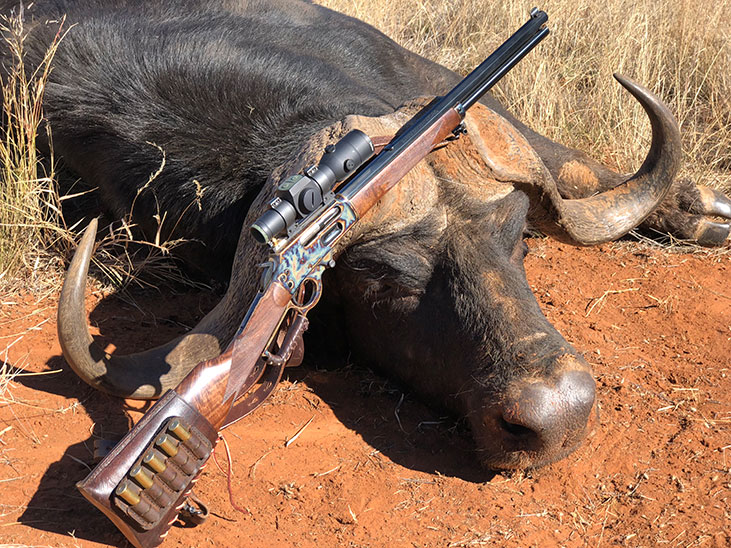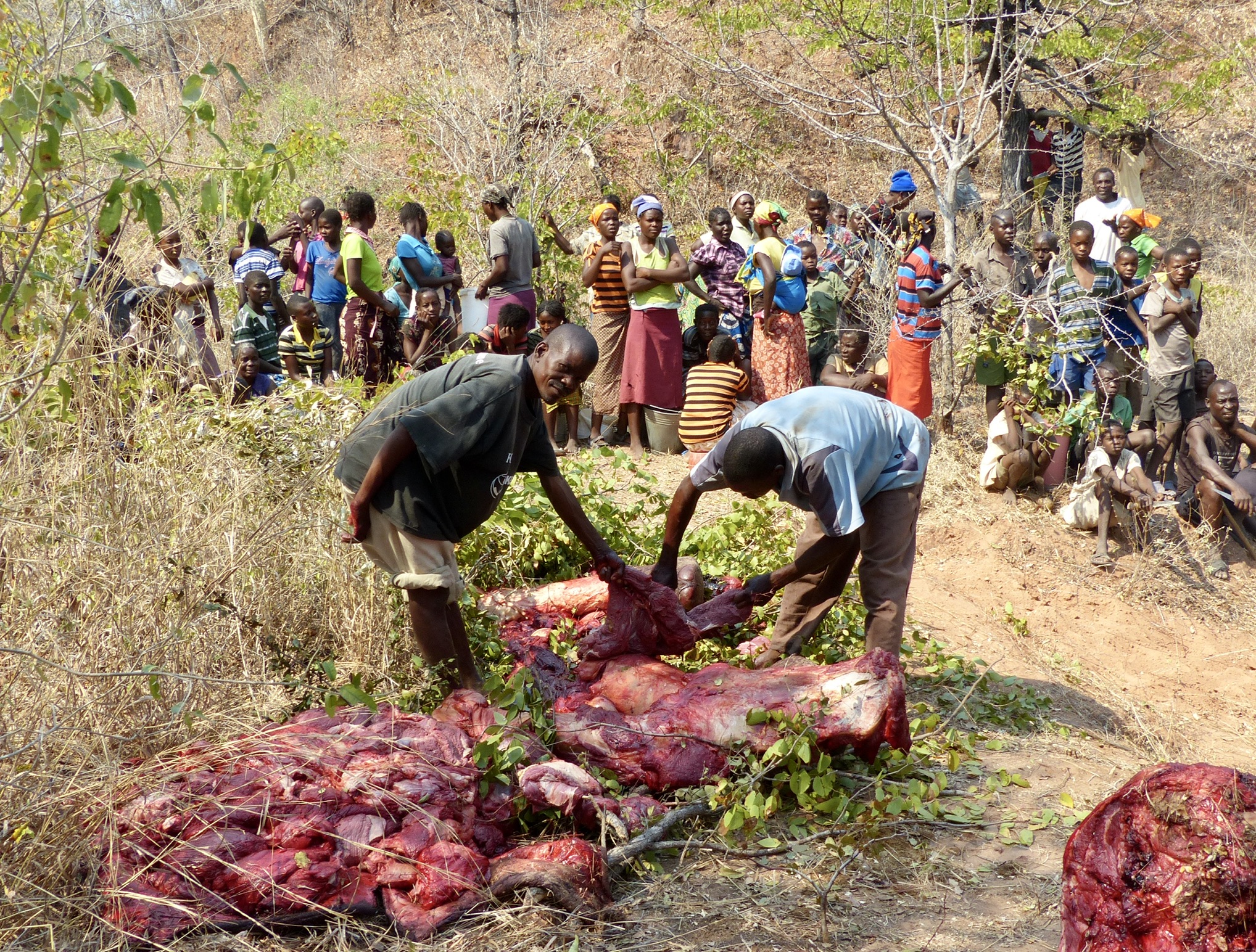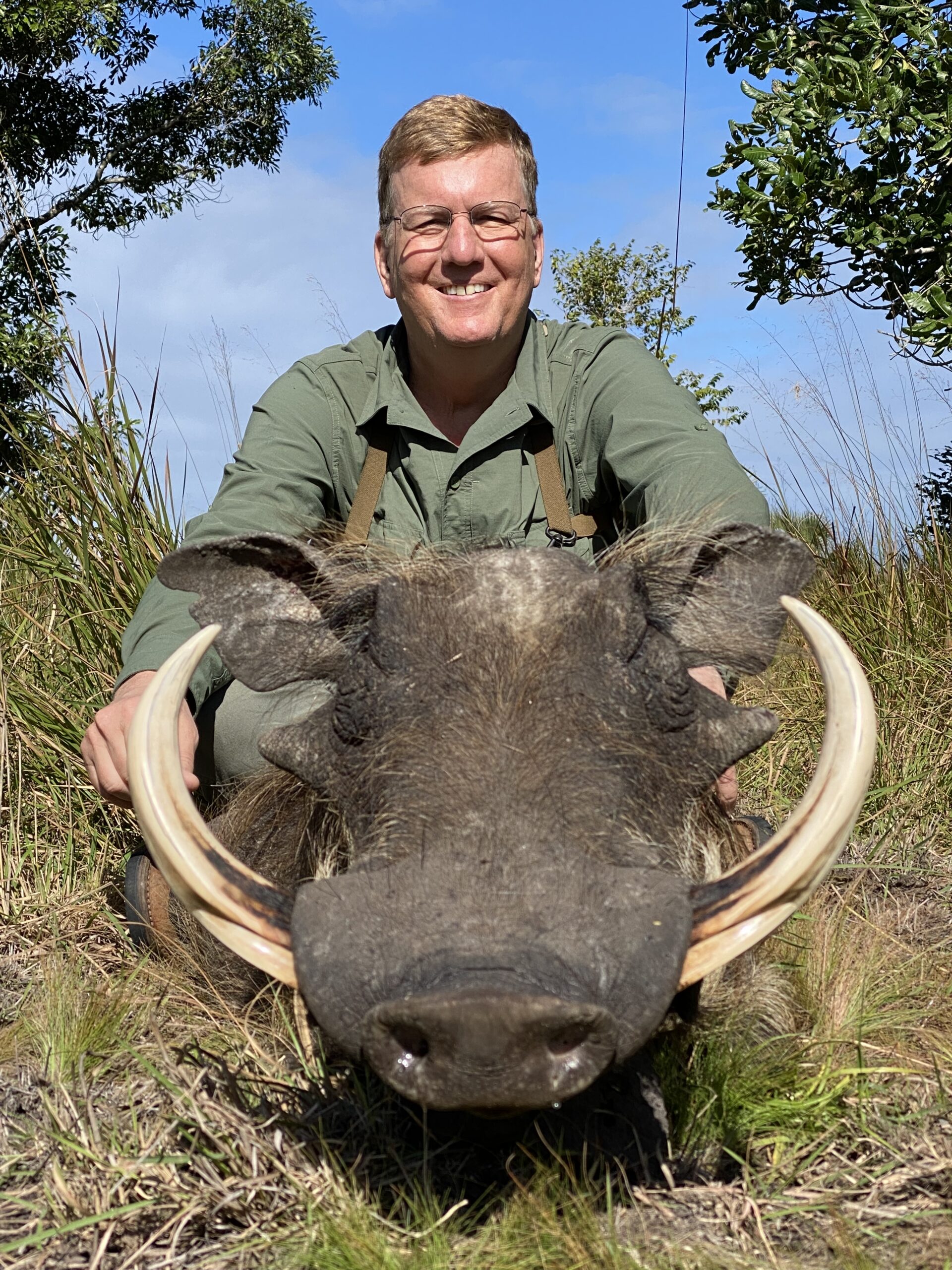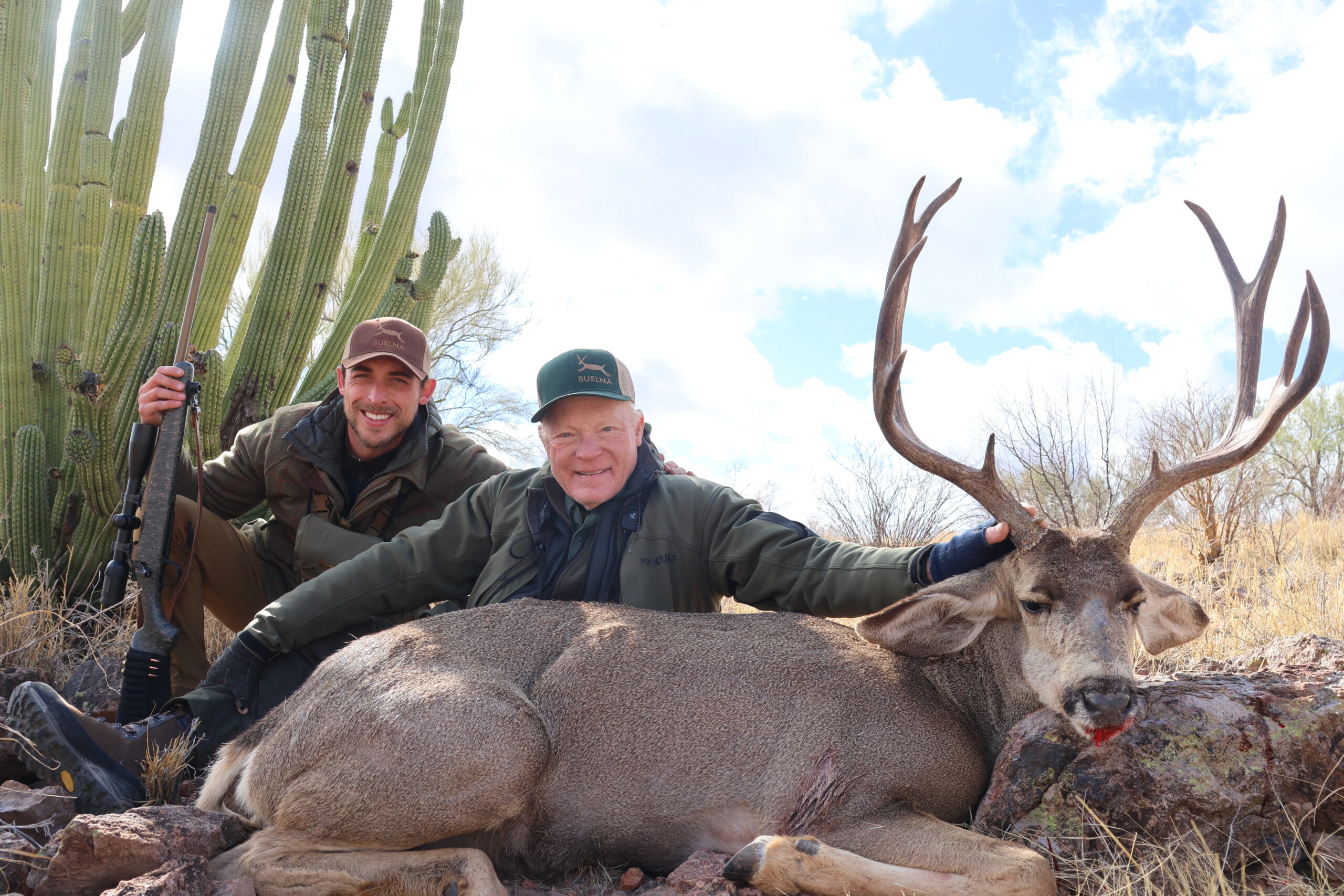It was still dark and cool, a couple of hours before the African sun would paint the veldt in colors.
“Come over here, Michael,” said my PH Geoffrey Wayland, pointing at a corner of the porch. “We have to talk a moment, alone. We have to talk about the buffalo.”
Wayland said that the big buffalo was going to come out today because we pushed him all day the day before.

“He’s separated him from his pals. He’s old, and he’s tired, and he’s not going to take this crap much longer,” said the PH. “He’s going to fight.”
The day before had been long slogging miles in the thorn, punctuated by moments of sheer terror, always a few steps behind the ghost in the thorn.
Geoffrey would once again carry a Dakota in .375 H&H. I would have my Marlin .45-70, a lever gun built to my specs for this trip.
“Tell me you’re 100 percent,” Geoffrey said.
“Always,” I said.
I was ignoring the fact that I got about two hours of sleep and spent most of the night going over the rifle. Almost like a nervous tic, retorquing the screws that held the Aimpoint red dot in its mount, a bit more oil on the lever mechanism, making sure for the umpteenth time I hadn’t overlooked anything obvious.
“How’s your knee?”
My right knee, or rather my former right knee — all the busted bones, replacement plastic parts and Rube Goldberg surgeries stitching it back together — feels like it has been hit with a baseball bat.
“Pretty good this morning,” I said, and Geoffrey stares at me.
Geoffrey, who is always smiling and laughing, isn’t smiling or laughing. “Then let’s go do this thing,” he said.
I can tell you the exact moment I became totally smitten with Africa. On my first-ever safari, we’d flown into Windhoek, the only real city in Namibia, then got onboard the Cessnas to head up north to the Bushmen, more properly the San, conservatories. I was in second seat and after a few hours, we circled a red sand landing strip on the edge of the great desert. The strip was also home for a herd of giraffes. Wild giraffes, not zoo giraffes, all staring at the plane.
“Somebody get out there and run those damned giraffes off the strip,” the pilot radioed. Looking at the giraffes in their ungainly gallop and a flood of wildebeests flowing in the distance, it suddenly struck me that Africa was real, and I was in love.
My second trip to Africa was with Fort Richmond Safaris in South Africa. I went with Richard Mann, now-retired firearms editor at Field & Stream, and as fine an outdoor writer there is.
We got the idea to pull off the Second Scout Rifle Safari…of course, Col. Jeff Cooper did the first one, and followed in the footsteps of Frederick Russell Burnham, the great Africa scout for the British in the Boer Wars and one of Cooper’s inspirations for the Scout Rifle concept.
After that trip, Richard and I started thinking about what we wanted to do next.
“I have an idea, dude,” I said. “Cape Buffalos with .45-70 lever guns.”

“That,” said Richard, “rocks!”
So, with the help of our longtime friend Carlos Martinez, then head of the Marlin Custom Shop (this was before Marlin was purchased by Ruger), we scheduled a trip back to South Africa — my third safari — specifically for buffalo.
It goes without saying that a Cape buffalo can gore, stomp and otherwise disassemble you in a myriad number of ways, all of which appear to be extraordinarily painful and usually fatal. That has big implications for filming, which we were doing for my TV show Shooting Galley. While stalking the dread whitetail deer, I will listen to the whispers of my film crew…speed up…slow down…don’t shoot…let us get in position…etc. All that goes out the window with dangerous game. The hunter needs to remain totally focused on the task at hand to avoid becoming a hunting statistic.
While we were still in the planning stages, I read every word I could find on “Black Death” from Ruark, Boddington, Burger, Capstick, plus the flood of contradictory stories on Ye Olde Internet. Then I called two of my best friends who have a couple of lifetime’s experience with buffalos, Tim Wegner and Larry Potterfield. Both Tim — founder of Blade-Tech Holsters, gourmet cook and old Africa hand — and Larry, whom I’m pretty sure needs no introduction, are two of the people I would trust with my life. What am I overlooking, I ask? What do I need to know?
First thing Tim and I did was huddle up with Tim Sundles from Buffalo Bore Ammo on what type of bombs we could launch out of a .45-70. We settled on 430-grain hard-cast lead flat-nose at around 1,925 feet per second. Do the math, and it ends up at 3,537 foot-pounds of energy, which would put that load between a .405 Winchester and a .450/400 3-inch Nitro Express in overall thump.
The gun I’d speced was an 1895 Cowboy .45-70 with an octagonal barrel cut to 18 inches, a straight stock and a Skinner “Express” peep sight on the receiver that would also mount an Aimpoint Hunter H30S with a 2 MOA red dot. Up close I have found nothing works as well — or as fast — as an electronic dot sight. With the sight, a leather butt cuff with a half-inch of Sorbothane in it and a leather wrap for the lever, the whole gun came in at a spec over seven pounds, three-quarters of a pound less than a Ruger No. 1 .450/400 with no sights, more than three pounds lighter than a Krieghoff double in .450/400.
The Marlin handled as well as any rifle I had ever put to my shoulder, and with Buffalo Bore dinosaur killers, the recoil was right on up there in Detached Retina Land.
I worked a lot off sticks, de rigueur in Africa, and what I think of as broken positions, such as off piles of rocks, tree limbs, prone with the gun raised on a log. What proved to be the most important things were drills from Mr. Potterfield, especially the charging drill.
“How fast can a Cape buffalo cover 50 yards?” Larry asked me.
I wasn’t sure.
“Seven seconds,” he said. “All you have is seven seconds if he’s 50 yards away.”
So, the basic drill was a target at 50 yards, a target at 25 yards and a small target at seven yards, with a par-time of seven seconds set on a shot-timer. I had a 12-inch plate at 50 yards, a 10-inch plate at 25 yards and an eight-inch plate at seven yards. I shot that drill a lot, pretty much until I saw it in my sleep.
I worked on “swing drills,” first shot off the sticks, swing 20 degrees for the second off-hand shot, which will be farther away, 30 degrees for the longest shot, simulating a wounded animal running away. I was also lucky enough to get some time on the safari simulator at FTW Ranch in Texas, one of my favorite places in the entire world, shooting charging buffalo targets or buffalos that sprang from the underbrush on their mechanized safari trail. If you’re going to Africa, you owe it to yourself — and your PH — to spend a few days at FTW. The instructors there have been there, done that and will make your African experience so much better. They might even be able to keep you alive.
After that, with all the paperwork in place, we left for Africa.
Let me tell you a little about Fort Richmond Safaris and the Wayland family. When you go, it’s like being adopted into a large, very friendly family. That family has owned and managed the Ft. Richmond property, about an hour and a half from Kimberly, the diamond capitol of the world, and near the Orange River, since 1869. You have your meals in the family home, usually the previous day’s successful hunt. The current Wayland, Geoffrey, learned his bush skills at the feet of his late father, famous professional hunter Neil Wayland. Geoffrey’s grandfather, John, was an early adopter of a holistic approach to managing the land, even reintroducing indigenous species long gone.

The first thing Geoffrey and I do is hammer out the details. You may not know this, but one of the most important things for you to do with a guide or professional hunter is to let them know what your expectations are. And they, in turn, will tell you how close they can come to meeting those expectations. Because I’d hunted with Geoffrey before and he understood the necessities of filming for television, it was easy-peasy.
“No farther than 50 yards. Preferably in undergrowth.”
Sure, Geoffrey said. “Just remember, this is your hunt. I won’t take a shot for you. I’ll try to save you if you screw up.”
I’m not first up in the hunting rotation, so Carlos Martinez went out before me. His long barreled .45-70 took an excellent bull at 100 or so yards.
I spent a day with Richard Mann hunting zebra with his .45-70 Marlin. That afternoon Geoffrey told me that he’s found a situation that just might work for filming. Seems there was a problem buffalo on one of the large ranches bordering a national park, likely in a paddock.
“Paddock,” I ask. “Like a pen?”
“Yeah right,” Geoffrey said. “A 5,000-, maybe 10,000-acre pen.”
In Africa, words have different meanings.
The terrain was 70 percent thorn with kopjes scattered around.
“He’s going to be hard to find in the thorn,” said Goeffrey. “Understand this, Michael — he’s old and he’s smart and he’s dangerous, and he’s going to be pissed off. You gotta know this going in. Brief your crew. Make sure they understand things can get sketchy quick.”
Before dawn the next morning, we’re on our way.
Geoffrey wasn’t joking about the thorn. It was like staring into hedgerows from hell. I already knew from earlier visits that every plant in Africa wants to hurt you. They hook, they stab, they slice, you bleed. The thing is, that thorns don’t look particularly dense until you’re in it, and you realize they’re impervious to sight. You can’t see a damn thing through them.
For a couple of hours, it’s no joy. We do a lot of tracks that amount to nothing. And then we get a bit of luck and actually see that disappearing buffalo tail at the end of a long corridor in the thorn. We pick up the pace…for hours. No buffalo. It’s like tracking smoke through a maze. What’s worse is now we’re deep into the thorn, and visibility has pretty much dropped to less than zero.
“He’s got to be in here somewhere,” Geoffrey whispers. “I swear I can feel him. Head on a swivel. He’s got to be…”
There is a loud snort from the other side of a thorn wall, three, maybe four, feet away from us. Spitting distance, as they say.
I hear Geoffrey whisper something that sounded suspiciously like a very bad word you don’t want to hear from your PH.
And the huge black boss suddenly appears above the thorn. The bull’s rheumy, bloodshot eyes lock on mine as both Geoffrey and I frantically struggle to get the guns in play. At three feet, we are inside the hook of his horns. All the bull has to do is shake his great head and we’re in serious, deadly trouble. The bull looks at me. Then snorts, turns and trots away.
“Safe your gun,” Geoffrey said to me. Adrenaline is boiling through my system like some teakettle gone berserk. I expect there is steam coming out of my ears. I put the safety on the Marlin, lower the hammer, then click the safety off. I notice Geoffrey is breathing a little heavy himself. Then he grins.
“Well,” he said. “That was different.”
“So,” said the videographer as I struggle to get my heart rate out of the stratosphere, “we weren’t really in danger, were we? You and Michael could still have shot him, right.”
“We could have shot him,” Geoffrey said, “but we couldn’t have stopped him.”

“Should I have run?” the videographer asks.
“If you had run,” Geoffrey said, “he would have killed you.”
We hike back to the safari truck for a quick, late lunch, and then pick up the trail again. Or attempt to pick up the trail. Wherever the buffalo was, he’s no longer there.
And then we look up the kopje. Near the top in the fading light, the buffalo stands watching us. He has us checkmated and he knows it. If we go up, he goes down into the thorn as the sun sets. If we try and wait him out, the dark will catch us in just a few minutes. Playing tag with a Cape Buffalo in the dark doesn’t seem like a wise idea to any of us. Short of calling in an air strike, he’s out of our reach.
We head back to the truck, a dispirited group. It’s slow going, as I am limping now.
The next day is when Geoffrey and I have our ex-officio meeting on the porch. Then the hunt begins much as the first one ended — in the thorn. The weather’s mild, but the day is heating up, and the thorn adds a claustrophobic intensity to the stalks. The first hours drag, I think mostly because we’re all remembering the buffalo, standing on the kopje looking down on us annoying monkeys.
“When he decides to fight, he’ll come at you from the shadows,” Geoffrey said. “He’ll back into the thorn and he’ll be hard to see, but he’ll see you just fine. It’ll happen quick. And even if you get a heart shot, he can continue going for five minutes. This is the toughest animal on earth.”
I nod. We decide to drive some more and look for tracks. After a couple of fruitless stalks, we are not far from where we started, our first encounter. The tracks, however, are fresh. We’re out of the truck in a flash.
Geoffrey nods at Leon and the tracker, and we’re off on the stalk.
We come out of the thorn into a small clearing. Geoffrey rounds a small bush and stops.
“He’s here,” Geoffrey whispers urgently for me to come alongside him. “In the shadow.”
The Marlin shouldered, I look through the Aimpoint into the shadow and see nothing.
But then the slightest movement, and the shadow dissolves into the front of the buffalo, less than 40 yards away, his eyes now locked on mine. His right hoof slightly paws the ground, and his eyes say it is time to conclude the business between us. Out of the corner of my eye I see Geoffrey with the .375 at the ready; on the other side I see Leon shouldering the double.
Forty yards, I think absently…6 seconds, Mr. Potterfield.
Then the universe slows to a crawl. Not only do I feel my heartbeat drop, but a wave of calm washes over me. It’s all so simple now, a simple binary choice. Geoffrey whispers the aiming point, and the red dot is there. I neither hear the blast of the 45-70 nor feel the recoil slamming into my shoulder. But I do hear the thwack of the heavy bullet slamming deep into the buffalo’s chest and heart. Through the sight see him go to his knees. The Marlin’s already levered for the next shot. There is a moment of a frozen tableau, all of us, the kneeling buffalo, me, Geoffrey, Leon, even the tracker and videographer frozen in place.
And then the buffalo comes out.
He is magnificent, fury personified, launched from his kneeling position like a rodeo bull out of the gate, his great horns lowered to make mincemeat of his attacker. I hear Geoffrey as I’m swinging the rifle on the buffalo. When all four hooves hit the ground. More than half the distance between us now gone, and as all four hooves touch the ground the buffalo turns slightly, choosing his target.
Once again, I neither hear the shot — a spine shot — or feel the recoil, but the .45-70 knocks the buffalo off his feet. I feel my head cycling back into Real Time and start to take a step forward. Geoffrey grabs me by the shoulder. “Dead buffalos kill hunters,” he said. And the great beast attempts to rise one more time. “Through the shoulders,” Geoffrey said, about the only shot I have. “Break him down.”

The third shot goes through the shoulders, and the buffalo will rise no more. Instead, he raises his head one last time and lets go a long mournful bellow, one final entreaty to the Horned God, I think, or maybe he’s just calling out his name in the face of the coming Dark. He has never known fear, and I don’t think he knows it now.
Geoffrey waves away the camera people and shepherds us away to a small copse of trees.
“Let’s give the old king the dignity he deserves,” Geoffrey said, and the cameras are lowered. That way they don’t record the tears in my eyes.
Michael Bane, a journalist, author, professional adventurer and firearms expert, has created some of the most innovative shooting sports programming in the world for Outdoor Channel and his Down Range Radio podcast.




